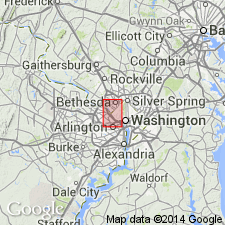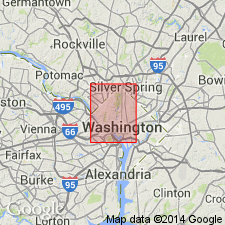
- Usage in publication:
-
- Clarendon Granite*
- Modifications:
-
- Named
- Dominant lithology:
-
- Granite
- AAPG geologic province:
-
- Piedmont-Blue Ridge province
Summary:
Named the Clarendon Granite for Clarendon, Arlington Co., VA. Unit is only exposed as saprolite in northern VA, however, granite appears in cores taken from the Clarendon Metro Station as reported by Huffman (1975). The Clarendon intrudes the Sykesville Formation and is of Early Ordovician age.
Source: GNU records (USGS DDS-6; Reston GNULEX).

- Usage in publication:
-
- Clarendon Granite*
- Modifications:
-
- Overview
- AAPG geologic province:
-
- Piedmont-Blue Ridge province
Summary:
The Clarendon Granite in the mapped area is only exposed in saprolite, but intrudes the Sykesville Formation in the Clarendon, VA area. Unit consists of leucocratic, moderate- to well-foliated, medium-grained, biotite-muscovite monzogranite. The Clarendon is of Early Ordovician age.
Source: GNU records (USGS DDS-6; Reston GNULEX).
For more information, please contact Nancy Stamm, Geologic Names Committee Secretary.
Asterisk (*) indicates published by U.S. Geological Survey authors.
"No current usage" (†) implies that a name has been abandoned or has fallen into disuse. Former usage and, if known, replacement name given in parentheses ( ).
Slash (/) indicates name conflicts with nomenclatural guidelines (CSN, 1933; ACSN, 1961, 1970; NACSN, 1983, 2005, 2021). May be explained within brackets ([ ]).

